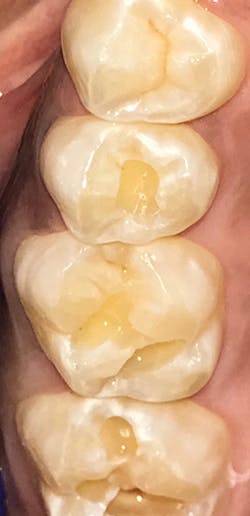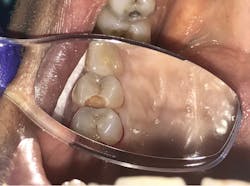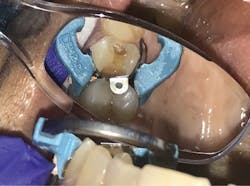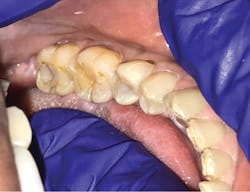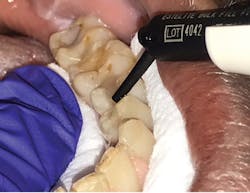Flowable bulk fills: Reduce work time and increase profit
Richard Lipscomb Jr., DDS
In dentistry, time is money. The more practical we are with our chair time, the better chance we have to increase both the number of patients we treat and our earnings. Whether it’s filling in cavity preparations, blocking out undercuts before fabricating indirect restorations, or repairing chipped porcelain or composite, this should be your mindset when making the simple decision to use bulk-fill materials.
Flowable bulk-fill composites are very versatile and the material of choice in a variety of situations. Flowable bulk fills streamline my options for routine restorative procedures (figure 1). They make me and my staff more efficient in choosing which material to use and deciding how we will deliver dentistry to our patients (figure 2). In this article, I will share some examples of clinical situations where I have elected to use a bulk-fill material.
Figure 1: Cavity preparation of teeth Nos. 3 and 4
Figure 2: Teeth Nos. 3 and 4 being filled with Estelite Bulk Fill Flow
Clinical examples where bulk fills work
Posterior Class II restorations can be challenging (figure 3). One way we can accomplish consistent and reliable Class II restorations is with the use of a flowable bulk-fill material and a sectional matrix system.
Once the cavity preparation is completed and the tooth is properly isolated, place the sectional matrix (Palodent Plus sectional matrix system, Dentsply Sirona) to seal the gingival margin of the cavity box and establish adequate contact with the adjacent tooth (figure 4). Apply the bonding agent of your choice and complete any other bonding enhancement steps.
Then, with the preloaded tip delivery system, express the flowable bulk-fill material into the cavity preparation. I use Estelite Bulk Fill Flow Shade A1 (Tokuyama Dental) in my practice. Starting from the matrix margin of the box, fill the entire preparation with the material. The viscosity of most bulk fills allows them to adapt well as they flow into the nooks and crannies, providing an excellent marginal seal and preventing restoration failure. Because of Estelite’s high translucency at placement and higher opacity when cured, it cures all the way to the bottom of deep restorations—this particular one is 4-mm deep—in only 10 seconds (about half the curing time of most bulk fills). This flowable bulk fill has a high compressive and flexural strength, so it does not have to be capped off with another composite resin. This eliminates a step in the process (figure 5).
Figure 3: Carious lesion involving the distal-occlusal surfaces of tooth No. 12
Figure 4: Placement of sectional matrix around tooth No. 12
Figure 5: Final fill of tooth No. 12 with Estelite Bulk Fill Flow
Although not as difficult as Class IIs, Class V restorations pose their own unique set of challenges. The gingival margins of these preparations present obstacles for bulk-fill materials. Placing traditional composite resin onto a Class V cavity preparation with a plastic instrument is the norm.
Some of the problems one faces when restoring these types of cavity preparations include moving the composite just the right way to cover the gingival margin, stopping the composite from running off the cavity preparation and into the soft-tissue sulcus, and properly covering the other margins at the correct buccal contour. Using bulk fills for Class V restorations eliminates pits and voids that could be caused by manipulating the composite with the plastic instrument and dragging uncured composite into position. Bulk fills are delivered to the cavity preparation through tips that can be used to guide the material.
Class I restorations and core buildups after endodontics are ideal for bulk fills. The cavity preparations are usually simple holes with self-containing walls in which the material can be placed (figure 6). These restorations can be completed in a very short amount of time with bulk fills (figure 7).
Figure 6: Pre-op of teeth Nos. 20 and 21
Figure 7: Filling teeth Nos. 20 and 21 with Estelite Bulk Fill Flow
In summary
One way to increase the number of patients we treat is to simplify our restorations. We can do that by incorporating a bulk-fill flowable material, which will reduce the amount of time for the procedure, making it easier for patients to tolerate dreaded dental visits. Our patients might even refer more patients to us in the process, so perhaps we won’t have to spend additional dollars marketing our practices.
All of these things add up to valuing our services, strengthening credibility between doctor/staff and patient, and increasing profits for our practices.
Richard Lipscomb Jr., DDS, is a 1993 graduate from Howard University College of Dentistry, in Washington, DC, and a 1993 graduate from the University of California, San Francisco, Advanced Education in General Dentistry program. He is a national lecturer and conducts seminars and hands-on training on restorative procedures and mini dental implants. He has been in private general practice in Mitchellville, Maryland, since 2001.
